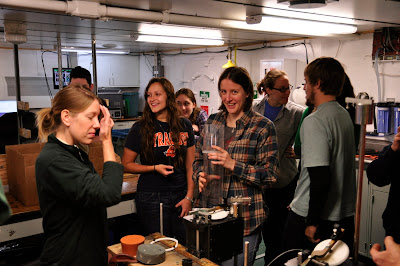
Dave Honig of Duke University with a collection of macroalgae from Robertson Island. Image courtesy of Amber Lancaster.
For the time being, heavy sea-ice has prevented the Nathaniel B. Palmer from reaching our primary target area within the Larsen B ice shelf. Thus we have initiated plan B, in which our benthic ecology team will address seafloor community response to ice shelf collapse in the Larsen A embayment, which sustained a major ice-shelf collapse in 1989. We have begun benthic (or seafloor) sampling at our outermost location, Station K. . Here we deployed an instrument called a Blake trawl, which collects lage benthic animals and (and lots of mud) from the seafloor for a defined distance, and then is later hauled on deck for sample processing. We also repeatedly deployed an instrument called a megacorer, which quantitatively samples seafloor sediments and mud-dwelling organisms using twelve tubes (i.e. “cores”) each 10 cm in diameter. Thus, each tube contains many epifauna and infauna (animals that live on the sediment surface, and within it, respectively) with many that are often new to science. Last but not least, our team is also using a system called a “yoyo camera”, which systematically takes pictures of the seafloor and the animals on it by being raised and lowered on a cable, taking a picture every time a weight contacts the seafloor.
Pavica preparing the materials needed for “mud busting” at Station K

A megacorer being deployed off the stern at Station K.
The first Blake trawl was deployed in the wee hours of the 21st of March, and marked the beginning of a slew of sample processing (or “mud busting”, as well call it) on the ships back deck and wet lab. In sub-freezing temperatures and equipped with forceps, the members of the Hawaii team quickly went to work heaving hundreds of pounds of sediment sludge onto a giant sieve table (which is made up of nested sieves with meshes ranging from 2 cm to 2 mm) to separate the megafauna (animals greater than or equal to 2 – 3 cm living on the seafloor) from the rest of the mud. After hours and hours of work, in conditions in which the spray from our wash hoses froze solid on our Mustang suits, encasing us in ice, we finished processing to trawl megafauna. Despite the lack of sunlight and a tropical climate, that night the Aloha spirit could be found persisting near 65º S, 57.8º W.

Mike with a giant sea cucumber, Bathyplotes bongraini, from the Blake trawl.
The following day our team collected another successful Blake trawl, capturing even more animals than last time. Fortunately, we had a few extra hands and worked in the daylight. The trawl sampling was sandwiched between processing of magecores, five of which were collected at Station K. This “mud busting” of megacore samples occurred round the clock for 3 days . Anytime after a megacore deployment is retrieved and placed back on deck, the 12 individual tubes are separated from the megacorer and carried carefully into the processing lab, an aquarium room open the deck. The sediment (mud) in each tube is carefully sliced into precise vertical intervals of 1 to 5 cm and very carefully transferred to sample bottles or plastic bags. Thus, we spend hours very précising cutting “mud pies” from our samples, taking great care not to lose any of this precious deep-sea sediment (no mud fights allows!). These samples will allows us to understand geochemical processes (such feeding by mud eaters) within the sediments, and to quantitatively describe the benthic fauna (i.e. infauna in this case) at various sediment depths. With muddy hands, hair, and clothes, and after multiple days of repetitive processing, our team finished our sampling at Station K happy and satisfied, albeit exhausted.

The Hawaii team picking megafaunal organisms from the table sieve.
Pavica mud-busting!
While everyone was working on >12 hour shifts, with time off used to grab meals and sleep, that’s not to say that we weren’t having fun. In addition to finding some cool marine invertebrates and fish during our sampling, we also ended up running into some of the celebrated Antarctic megafauna. A group of three Emperor penguins off the NBP’s stern, and about 12 penguins off the port side, took great interest in the Nathaniel B. Palmer. Our three aft penguins approaching the ship to within 5 m (15 ft) of the main deck on a bridging ice-floe. Amazing!

Three curious Emperor penguins were spotted not far off the stern of the ship, and slowly approached.

The penguins approached the stern of the Nathaniel B. Palmer to the delight of the scientists and crew.




























